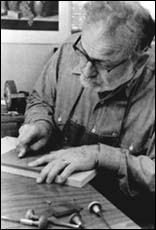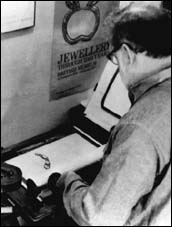
DRAWING
An ideal specimen must be found, and the best viewpoint must be selected. The drawing is done in pencil on paper. Special care must be taken at this stage of the work, as the results from the drawing will carry through to the completion of the print.

CUTTING THE BLOCK
There is, before the cutting begins, another stage not shown here: the pencil drawing on paper becomes a model for the drawing that is made, also in pencil, on the linoleum block. After this second drawing is done, the cutting can begin.

INKING THE BLOCK
After the right ink color has been mixed, a small quantity is rolled out smooth on a glass plate and then onto a block mounted in the press. There has to be a separate block for each color in the print. If a print has four colors, it must be printed four different times. The freshly printed sheet must dry overnight.

PULLING THE PRINT
The press was built by the Robert Hoe Company in New York in 1852. The lever and toggle-joint mechanism creates enormous pressure on the platen, so fairly large masses of ink can be printed reasonably well. About forty impressions per hour are obtained when everything is going well.

RAISING THE TYMPAN
The bed of the press is rolled under and out from under the platen by means of a handle in front of the printer's left hand. There is very little variation in the image from one impression to the next. After the impression has been made, the tympan is raised.

EXAMINING THE PRINT
The print is actually inspected many times while it is being made, and then afterwards when it is being signed. Prints that do not pass inspection are destroyed. When the printing is completed, the blocks are also destroyed.







